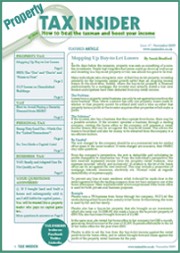Before you go, sign up to our free tax saving email course. Get 7 top property tax saving strategies in your email inbox that will help you save thousands in tax. Unsubscribe any time.
 At the beginning of April this year, HMRC published an innocuous sounding document called “Revenue and Customs Brief 5/2013”, which contained “draft revised guidance” on repairs and their treatment for income tax and corporation tax. At the beginning of April this year, HMRC published an innocuous sounding document called “Revenue and Customs Brief 5/2013”, which contained “draft revised guidance” on repairs and their treatment for income tax and corporation tax.What’s changed? Within this document was confirmation that HMRC will no longer accept claims for the extra-statutory “renewals allowance” for expenditure incurred after 5 April 2013 (1 April for companies). This was announced some time ago, but I suspect everyone had forgotten about it, but it is now here and will severely affect landlords of residential accommodation. The renewals allowance was an old practice that first grew up before capital allowances were available, which effectively gave a tax deduction for the depreciation of items of plant and machinery. The cost of the purchase of the first item was not allowed, but after that the cost of replacing it was – subject to adjustments for any sale proceeds of the old item or for any element of improvement in the replacement item. The withdrawal of the renewals allowance applies to all businesses using plant and machinery, but it will hit landlords of residential property particularly hard. This is because unlike any other trade or business, a landlord of residential property cannot claim capital allowances on plant and machinery that is for use “in a dwelling house”. Jane, in the example above, cannot claim capital allowances on the furniture in her let property – whereas if she were letting out furnished offices, she could. Wear and tear allowance So what is the alternative? Provided the property is “fully furnished” (which HMRC take to mean that the tenant can effectively move in with just a suitcase full of clothes and find everything he needs in the way of beds, chairs, tables, and kitchen appliances, crockery, and so on) the “wear and tear” allowance can be claimed instead. This is calculated as 10% of the rent on the property (less any part of the rent that covers items like electricity etc that would normally be paid directly by the tenant). In some cases, the wear and tear allowance may give a better result than the renewals allowance, but not in every case, and the point is that there is now no choice. No relief at all? Landlords of unfurnished or only partly furnished accommodation are even worse off – they cannot claim the wear and tear allowance, and now they cannot claim renewals either. So what is left? The only possible claim is for repairs, and HMRC have made it quite clear that replacing (say) a worn out television with a new one is not a “repair”, because it is a replacement of “the entirety” of the item. The only good news is that they will accept that replacing fixtures (the boiler in the central heating system, for example) is a repair because it is a repair to the building. Trap I have heard it suggested that one way round this problem is to set up a company to buy furniture and then rent it to the property business – the idea being that the rental company will be able to claim capital allowances on the furniture. This is likely to be caught by the rules on “special leasing” which specifically deny capital allowances on plant leased to be used in a “dwelling house” Practical Tip : If your property is only partly furnished, consider making it fully furnished – at least you will be able to claim the 10% wear and tear allowance. Alternatively, go to wholly unfurnished – if you can’t get an allowance for replacing it, why provide it? This is a sample article from the monthly Property Tax Insider magazine. Go here to get your first free issue of Property Tax Insider. |


 Tax Articles
Tax Articles